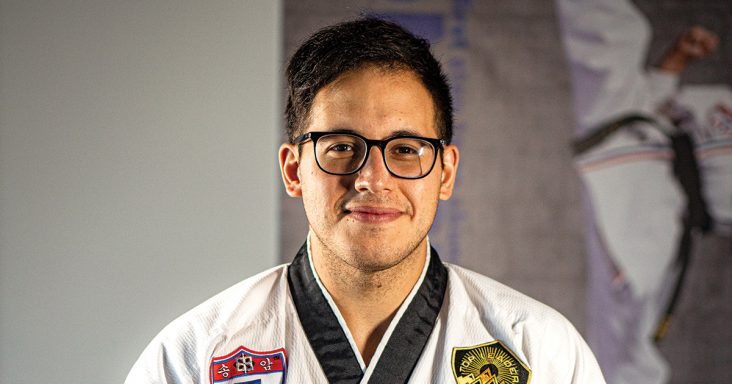Paraguayan martial arts master teaches ‘discipline, social and life skills’ to next generation
by December 15, 2020 9:30 am 1,515 views

Francisco Baez.
Francisco Baez was born into a world dominated by martial arts in his native Paraguay. Generations of his family taught the sport codified in various self-defense techniques. Each of his forefathers attained a black belt, one of the highest achievements in any martial arts discipline.
Even as a child, Baez dreamed of owning his own studio and training the next generation of fighters.
There were two problems, however. It was not possible in his South American home country to compete in tournaments and make a living, so he took a chance and competed in tournaments in the United States.
Since 2013, Baez won four sparring world championships with ATA Martial Arts (formerly the American Taekwondo Association), internationally based in Little Rock, he told Talk Business & Politics. During that span, Baez finished as a runner-up four times and admits the losses linger inside him far longer than the victories. ATA moved its headquarters to Little Rock in 1977.
He now runs his own dojang, or studio, in Jonesboro and trains hundreds of students there and at The Trim Gym, the largest all-purpose gym in Northeast Arkansas.

Although its roots can be somewhat traced back to ancient Korea, the art of Taekwondo is relatively modern. The documented history begins in the mid 1900s, according to ATA International. The beginnings of Taekwondo have been obscured by time, yet many historians believe it originated from a Korean martial arts form known as t’aekyon practiced 1,300 years ago.
In the early 1900s, the art evolved with the introduction of Chinese and Japanese techniques, a practice that concerned some because the influences did not demonstrate the kicking power of the art nor its traditional values or philosophy.
The name (and art) of Taekwondo did not become official until 1955. At that time, Korean General Hong Hi Choi organized a movement to unify Korea’s various martial arts styles (called Kwans) and presented the name “Taekwondo” to a committee formed to select a name for the new art. On April 11, 1955, Taekwondo was recognized as the name for the newly unified, officially recognized Korean martial art, the ATA reported.
In the 1960s, Taekwondo began to spread internationally and evolved throughout the late 1900s, along with most martial arts, into primarily a combat sport. However, self-defense, fitness, and the philosophy of the practice — including self-discipline and self-knowledge — are still crucial elements of Songahm Taekwondo, the style of Taekwondo developed and supported by the ATA.
Martial arts as an industry generates about $5 billion in the U.S. each year, according to industry research firm IBISWorld. The industry grew on average by about 3.7% annually from 2014 to 2019. Over the next five years, it is expected to continue growing because of the popularity of mixed martial arts.
The sector employees about 90,000 workers nationwide, and supports, completely or in a complimentary way, an estimated 80,000 businesses, IBISWorld reported. Classes can cost a student from $40 to $150 per month on average.
Children are typically identified as martial arts students, but research by several firms shows that’s not always the case. Simmons Market Research shows 18.1 million Americans practiced a form of martial arts at least once between 2010 and 2011, comprising 9.4 million adults, 5.5 million teenagers, and 3.2 million children. About 52% of members were men, with 48% women. The gender breakdown has changed since, with an even higher percentage of males participating, according to a report from glofox.com.
A 2018 report from Statista shows a correlation between income and participation in martial arts. About 7.83% of respondents who stated their income was high said they participated in the activity. This is also the case in a report from Simmons Market Research. The report revealed that 28% of children who take part in martial arts training are from households earning a minimum of $50,000. In comparison, just 10% of those from families earning less than this figure take part in martial arts.
Baez honed his skills in his youth and he jumped at the chance to compete in the U.S. He won a tournament and caught the attention of the ATA leadership. He was offered an instructor job, and called home to tell his parents. His parents offered their blessing, and he decided to stay in Arkansas.
The obstacles were numerous. He didn’t speak English and had no close family or friends. He spent months watching YouTube videos learning English. During instruction periods, he carried an English/Spanish translation dictionary.
Baez learned the language and the culture and soon after, he met his now wife, Mariela Gomez Baez. She’s a college student, studying to be an investigative reporter. She also is a participant in martial arts. The couple moved to Jonesboro after Baez decided to help his uncle who began an ATA studio in the region’s largest city.
In addition to his dojang and classes he teaches at The Trim Gym, Baez is active at regional ATA tournaments. He continuously interacts with students.
“There are no days off. I get messages from kids and their parents all the time,” he said. “We don’t take weekends off. This is very much a lifestyle.”
Baez said he hopes to grow his class sizes in the coming years. He wants to expand and add more studios throughout the state. Students learn about discipline, focus, physical conditioning, leadership, respect and many other life lessons, Baez said.
The budding entrepreneur is also dabbling in the real estate market. He has put out multiple bids to acquire rental properties in the region. But, no matter what else he does, he plans to spend the rest of his life carrying on his family’s heritage.
“For me, it’s my family’s legacy. I cannot imagine my life without martial arts,” he said.
